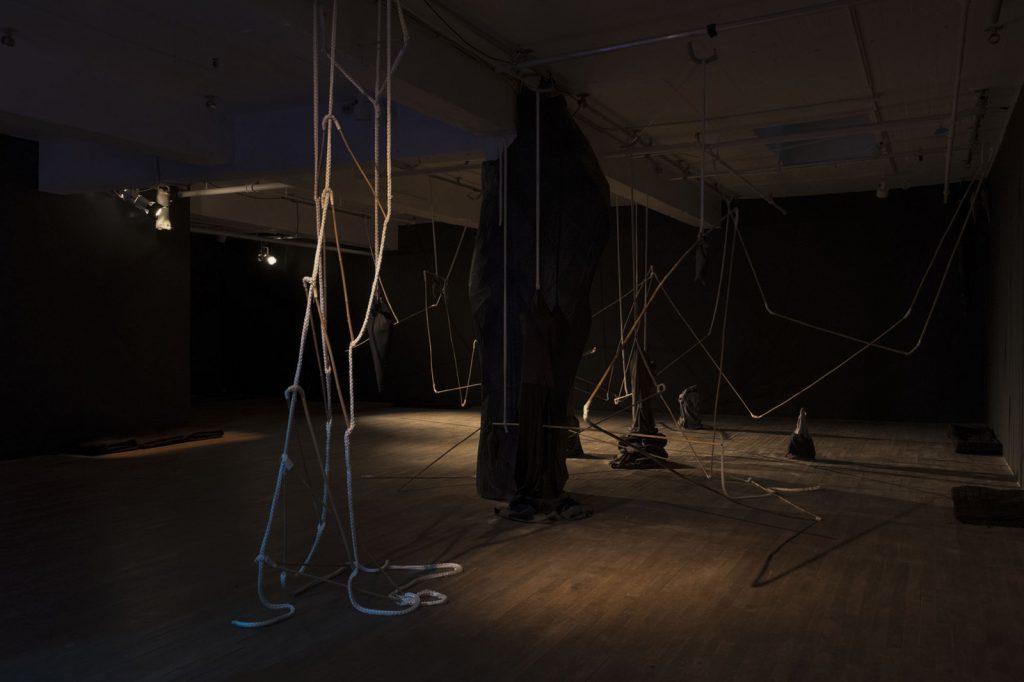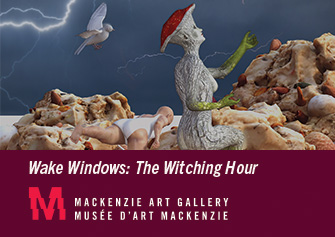The Sentient Object: Calder versus Hay
28 August 2019
By Maryse Arseneault
Last winter the Montréal Museum of Fine Arts held a retrospective on Alexander Calder, which offered a rare chance to share space with his famous mobiles, arguably the precursors of kinetic art. Breaking the threshold between abstraction and figuration, Calder’s suspended creature-like objects were born from subtle mechanisms with slow reactions and a geometric formulation that lures and lulls, favouring a contemplative spectator. The American artist marked modern art with his conception of these performative sculptures, and continues to be an important influence on new generations of sculptors who have succeeded him. As part of this succession, the artist-run OBORO centre invited Toronto and Brooklyn-based sculptor Sherri Hay to produce new sculptural activations in their space during the fall of 2018. Calder and Hay—who seem to be working with, at times parallel and at others, divergent motivations—position their practices as a kind of metaphysical response. Equally preoccupied by contemporary concerns, Calder is interested in the phenomenon of movement and the relativistic notion of “space-time”, while Hay inclines towards a neo-materialism that helps unsettle some of the more entrenched conceptual limits of the Anthropocene. In both cases, the idea of a mechanical object’s agency compels a kind of radical empathy towards the material and confronts us with our imperious relation to the object.
In a 1946 text on Alexander Calder, Jean-Paul Sartre evokes the abandonment of the creator in front of his work, with his choice of unrefined materials often left to endure fluctuating weather. The philosopher attributes a certain laxity to the artist’s ego during the interwar period, though extending this diminished egotism to the notion of an agency ‘specific to the object’ does not seem to be the primary concern of Sartre’s statement. Although we can observe a certain vital impetus in Calder’s sculptures, which “borrow their life from the vague life of the atmosphere” (1), their movements are dependent on the environment in which they are placed (the sun, the heat, the wind) and not on an autonomous will that inhabits them. With her recent endeavors in the show ici présente / time being, Sherri Hay suggests moving towards a complete abdication of so-called creative mastery, trading in her artistic right for a genuine reciprocity between human and object, a facilitated liberation of the device which enables the object to determine its own destiny.
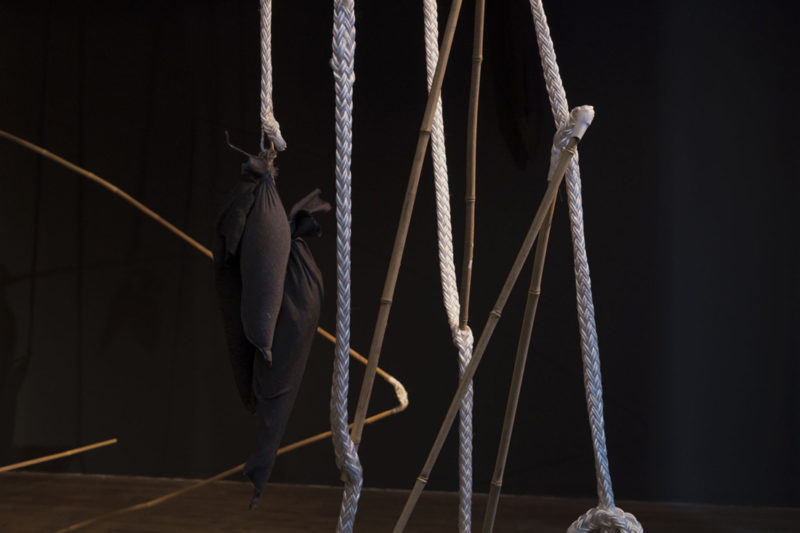
Her intentions as a creator put her in perpetual negotiation with the unpredictable mechanisms that will form her installation. (2) She aspires, not to the manipulative sway of a Geppetto, but to the same intersubjective respect that is brought forth by pure, wholesome, unmitigated collaboration. Taking care to remain receptive and empathetic towards non-human matter is to stay authentic to an overall material inter-connectivity.
To better understand the sensibility of her creature, Hay selects unassuming materials whose potential—compositional affinities, mechanical tendencies—is muted or unknown, and lets the “thing” grow organically. What actions will follow? What form will the construction take? How does the perception of movement become a qualifier for the perception of the living? The installation consists of ropes threaded through bamboo rods and suspended by a system of pulleys and weights. Some pockets of sand adorn the fine-jointed structure; we guess they will contribute later to its deployment. In front of this huge mantis offspring one remains worried, not knowing when, nor by which mechanism it will be activated, pistons, sandglass systems or vapour pressure, though we listen and we hear it. When Hay decides to explore the idea of empathy in her sculptural work, she wonders why she has to create objects in motion: perhaps this is to illustrate the latent kinship between all moving things, whereby constant motion, both at the molecular level and the macrocosmic, keeps us in a pathetic state of perpetual vertigo? In a text accompanying the exhibition at OBORO, curator Stephen Lawson explains that the various elements of which objects are made interact at the cellular level, and that interaction, on a microscopic scale is in constant vibration. It is in the presence of this non-human breathing that Hay instigates the possibility of empathy across a vast material ontology.
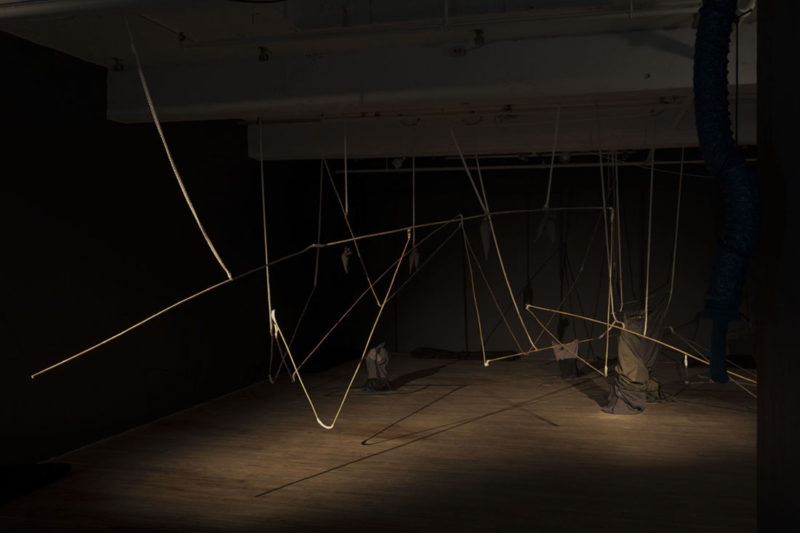
If Hay’s work considers an expanded conception of the living, then it may bear some comparison to Calder’s intention to “make something that is like a dog or like flames, something that has a life in itself” (3). Was he wondering about the life proper to objects as Hay does in ici présente / time being? It is always a question of dichotomy—of how an object invokes two opposing terms—in Sartre’s discourse, with “these strange beings, halfway between matter and life…between servility and the statue.” (4) But have we come to consider in contemporary art, that there is life intrinsic to the material? Is it time to examine more closely the will of the object that unfolds before us and not through us? In both exhibitions we are invited to live a moment with the object in order to feel its presence, to be surprised by a movement coming from the object itself, to remain empathetic towards the strange being who shares our space. For Calder, the wind makes the object dance following a mechanical direction conceived by the artist, while for Hay, in spite of herself, objects become dancers, not as interpreters of an intention but as actors of their own free will. Calder’s creativity stems from his knowledge of mechanics and a desire to “know how as much as to understand” (5), and although his observation skills (especially in Animal Sketching (1926)) opens up to the possibility of the non-human object as a sentient being, his regard for the object’s genuine autonomy is limited by an empirical desire specific to humans to exercise some control over their environment.
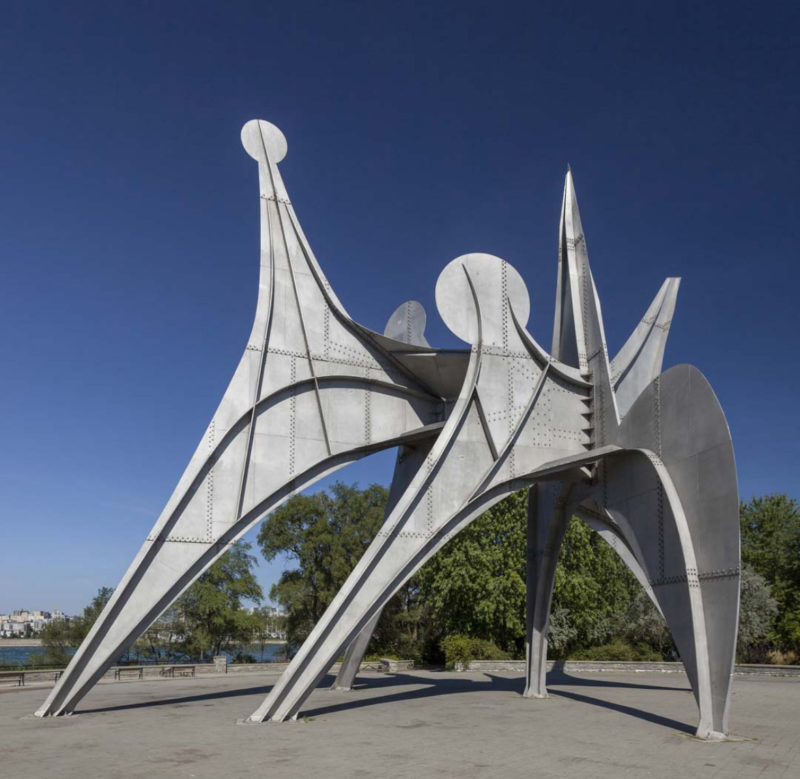
A considerable factor that separates these two sculptors is their position in time, acting at opposing cusps of something that is still barely palatable: an era of industrialization, of acceleration and over-consumption which entrenches our debasement of the object, of matter and of land. In her presentation at OBORO, Hay posited that in the advent of the disposable object, our relationship to matter is reflected in our relationship to the earth, to ourselves and to each other. At her artist talk, Hay also recalled the European perception of the New World: a clean slate, a promised land and a flattened one, whose natives were described in encyclopedias of the time as mere fauna and flora. This tendency to dehumanize, to deny someone the full dignity of their being, is not unlike the tendency to deny, or to render imperceptible, those signs of material’s living condition. To revoke our license on earth, as a matter of getting back in touch with it, maybe even leveling down to it, is a humble attempt at acknowledging that the earth does not belong to us, and that our dominion is illusory.
1. « empruntent leur vie à la vie vague de l’atmosphère », Jean-Paul Sartre, “Les Mobiles de Calder,” Alexander Calder: Mobiles, Stabiles, Constellations, exh. cat. (Paris: Galerie Louis Carré, 1946), 9–19.
2. Sherri Hay, « ici présente / time being », artis presentations at OBORO, Montréal, 2018 http://www.oboro.net/fr/activite/ici-presente-time-being
3. « faire quelque chose qui soit comme un chien ou comme des flammes, quelque chose qui ait une vie en soit », Alexander Calder, 1898-1976 : 10 juillet-6 octobre 1996, Musée d’art moderne de la ville de Paris : [catalogue d’exposition], quoted on back cover of catalogue
4. « êtres étranges, à mi-chemin entre la matière et la vie, (…) entre la servilité et la statue », Jean-Paul Sartre, “Les Mobiles de Calder,” Alexander Calder: Mobiles, Stabiles, Constellations, exh. cat. (Paris: Galerie Louis Carré, 1946), 9–19. Translation by Chris Turner, The Aftermath of War: Jean-Paul Sartre (Calcutta: Seagull, 2008).
5. Calder’s first training, received at the Stevens Institute of Technology in Hoboken, New Jersey, was technical and scientific: he successfully completed a mechanical engineering degree between 1915 and 1919. « Savoir faire, aussi bien que connaître » : the motto that opens the student booklet attested to the educational philosophy of the institution https://www.universalis.fr/encyclopedie/alexander-calder/2-un-art-verite/
* La Terre des Hommes (the Land of Men) was the theme for the International Expo of 1967, akin to Calder’s giant public sculpture Trois disques (Three Discs) anchored on Île Sainte-Hélène for the occasion (facing Montréal), and has since been baptized L’Homme.
ici présente / time being ran from November 10 – December 15, 2018 at OBORO in Montréal.
Alexander Calder: Radical Inventor ran from September 21, 2018 – February 24, 2019 at the Montréal Museum of Fine Arts.
Feature Image: ici présente / time being, 2018 by Sherri Hay. Photo by Paul Litherland courtesy of OBORO.

